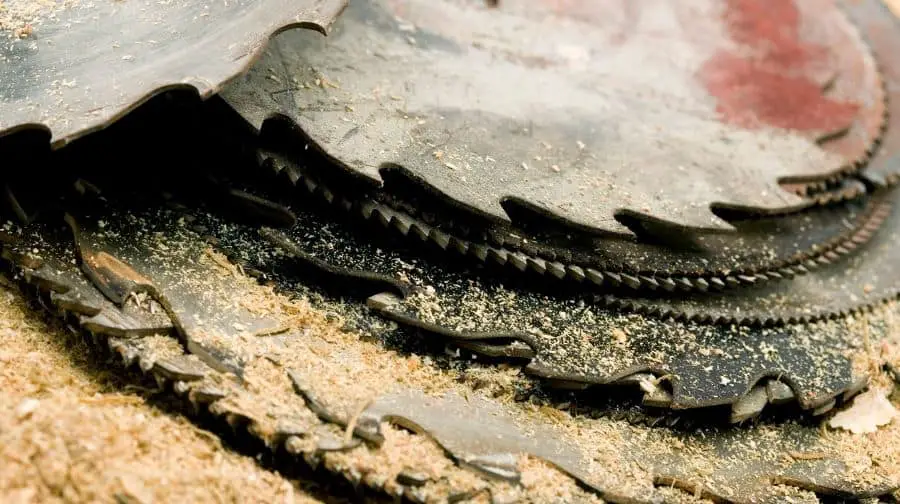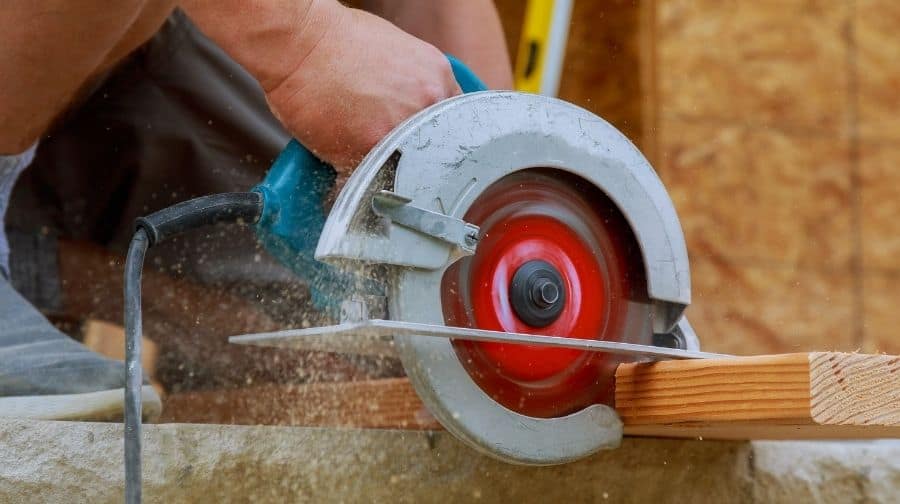
When a circular saw blade becomes dull, it must be replaced or sharpened to maintain safe and effective cutting power. If you hear your saw’s engine struggling to cut or if cutting takes longer than usual, your blade is dull.
Although the tungsten carbide-tipped blades, which are most prevalent currently, generally last a long time, you may occasionally need to change circular saw blades due to a change in the material being cut.
In any event, the procedure for removing and replacing the saw blade will differ according to the model of your saw.
Take advantage of the opportunity before installing your new blade to cleanse the top and bottom blade guards and remove any collected sawdust. Make sure that the replacement blade fits your saw correctly, both in terms of the center hole as well as the overall diameter. Retighten the bolt after the replacement blade is in position.
Table of Contents
How To Change A Blade On The Circular Saw
When updating your blades, the best course of action is to follow all manufacturer recommendations meticulously. A circular saw blade is by far the most critical component of a high-quality instrument.
Here are the steps to change a blade on the circular saw:
- Disconnect the power to your saw either unplug or remove the battery.
- Use your wrench or key to unlock the blade. Press the spindle lock to hold the blade in place while you gently rotate counter clockwise to loosen the bolt and remove it and the washer attaching the blade to the saw.
- Flip the saw over and lower your blade guard to remove your blade.
- Insert your new blade making sure the teeth are pointing up toward the front of the saw.
- Once the blade is in place attach the washer and bolt then tighten with your hand before fully tightening with your tool.
Reasons For Changing A Circular Saw Blade:
- The circular saw blade is worn down to a dull state.
- The circular saw blade has been damaged.
- The circular saw blade has rusted.
- Having to use extra force on the circular saw to make a cut.
How To Change Circular Saw Blades
Subscribe to The Honest Carpenter on YouTube
This video will show you how to change out a typical circular saw blade. You’ll also learn how to determine when it is actually time for a circular saw blade change, rather than relying on the saw blade’s appearance (which can be misleading).
How Do You Change A Blade On A Circular Saw Without A Lock?
Certain older circular saws lack a blade or shaft lock. There are two methods for securing the blade while releasing the bolt.
- The first step is wedge a screw driver in between a saw tooth and your base plate to hold the blade in place so you can loosen your bolt to remove the blade.
- The second method is to use Vice-grips or other locking pliers to secure the blade while releasing the bolt. If the bolt is not loosening but instead rotating the motor, the blade stays secure; tap or snap the wrench to release it. Remove the outer washer and bolt.
After removing the bolt & outer washer, carefully grasp the blade and pull it away from the shaft and through the base plate. For more clearance, you may need to twist the retractable blade guard.
Here are the steps:
- Unplug or remove the battery to the saw.
- Put on a pair of work glove to avoid any cuts from the blade.
- You may secure the blade in place with a screwdriver or attached a pair of vise pliers to the blade to secure the blade stationary.
- Once the blade is secure remove the bolt gently without making any abrupt movements. It should be positioned in such a way that it is readily removable.
- Once it is dislodged, gently remove the saw blade.
How to Remove Saw Blade With No Spindle Lock Or Broken Spindle Lock
Subscribe to The Fixer on YouTube
How Long Does A Circular Saw Blade Last?
You might be wondering how long a circular saw blade will last. The answer may surprise you. With proper care and maintenance, a circular saw blade can last for years.
Here are a few tips to help you get the most out of your blades:
-Use the right blade for the job: Choosing the right blade for the job is important. If you’re cutting softwood, use a blade with more teeth. If you’re cutting hardwood, use a blade with fewer teeth.
-Keep your blades clean: Over time, your blades will get clogged with sawdust and debris. When this happens, it’s important to clean them off. You can do this by using a brush or compressed air.
-Sharpen your blades regularly: Just like any other tool, your circular saw blades will eventually get dull. When this happens, you’ll need to sharpen them. You can do this yourself with a sharpening stone or you can take them to a professional.
With these tips in mind, you can be sure that your circular saw blades will last for years to come.
What Is The First Step In Changing The Blade On A Circular Saw?
Disconnect the circular saw’s power cord or remove the battery. If using a regular circular saw, disconnect the power supply; if using a cordless circular saw, remove the battery.
This is a vital measure to take to avoid serious harm. Even an experienced woodworker might unintentionally push the start button when replacing a circular saw blade. It is critical to adhere to all safety precautions when dealing with any dangerous tools.
How Do You Loosen A Circular Saw Blade?
Disconnect the power cable from the saw from the electrical socket or extension cord. Alternatively, if the saw is cordless, remove the battery. Rotate the blade till the locking mechanism connects by pressing down on the arbor-lock button on the saw. Remove the arbor nut that secures the blade into place using the blade wrench. Rotate the wrench in the same direction as the blade cut to release the nut.
When Should I Change My Circular Saw Blade?
You should change your saw blade when it takes longer to make cuts, causes rough and jagged edges, if it missing carbide tips, or if tips look or fell dull.
When the circular saw blade deteriorates, it must be replaced or sharpened to maintain maximum cutting power. You’ll notice this immediately if the cut takes longer than normal. Additionally, many types of materials need the use of a specific blade.
When a blade becomes dull, you’ll notice that it cuts less efficiently and may even leave a jagged edge. However, do not fret changing the blades because it’s is a quick process!
Subscribe to B&O Craftsman on YouTube
Why Does My Circular Saw Spin Backward?
Your circular saw can spin backwards if your blade is attached in the wrong direction, motor malfunction or even a malfunctioning power source.
When your circular saw starts spinning backward, they are in a hazardous scenario and should stop immediately until the problem is identified. The most frequent source of this type of problem is an electrical failure.
The following is a step-by-step approach to assist you in resolving this issue.
- Unplug the saw from the power source and double-check that you installed the blade in the proper orientation in the first place. There are usually arrows indicated on the blade disc to help you. The blade should be positioned in the motor’s direction of rotation, which is counterclockwise in front.
- If the blade is securely attached, locate, and connect a fan to the same socket. Table fans must spin counterclockwise. If it begins to spin in the other direction, this may indicate that your power supply is defective.
- In this scenario, move the fan to a different location in the home and check to see if the issue remains. If this is the case, contact an electrician to inspect the electrical system. If the problem is localized to the socket, you might try to reset the circuit breakers.
- If the saw is the source of the problem, you should get it inspected since internal connections may be defective.

How Tight Should A Circular Saw Blade Be?
Your circular saw should be firmly tight but you don’t need to over tighten the blade because the direction the blade spins will continue to tighten the bolt in place.
In general, right-handed circular saw blades turn counterclockwise, requiring you to tighten the bolt clockwise; left-handed circular saw blades turn clockwise, requiring you to tighten a bolt counterclockwise. With a wrench, secure the nut’s outer flange (rim) to prevent it from rotating.
Circular saw blades should always be snug, but not too snug. When you switch on your saw, it will vibrate and create a buzzing sound if the blade is too loose. Use an Allen wrench or hex key included in many tool kits to tighten the screw that attaches the blade to the arbor. Most screws have a right-hand thread. This indicates that the screw is twisted left for loosening and right to tighten.




